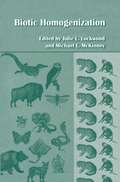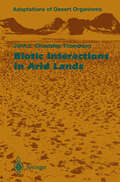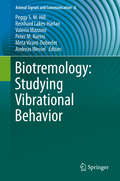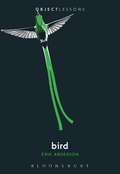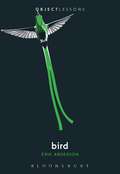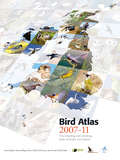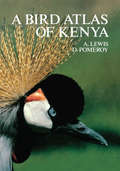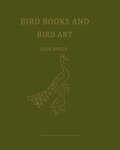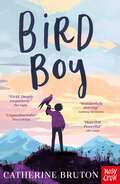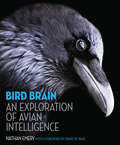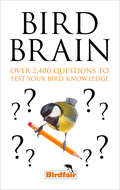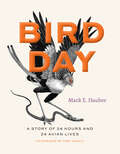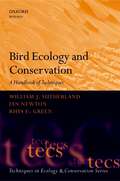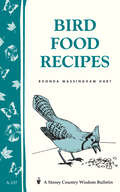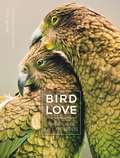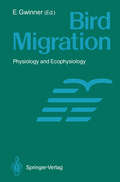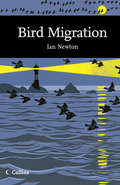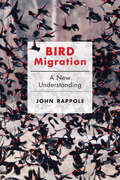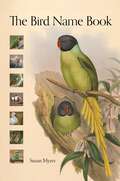- Table View
- List View
Biotic Homogenization
by Michael L. McKinney Julie L. LockwoodBiological homogenization is the dominant process shaping the future global biosphere. As global transportation becomes faster and more frequent, it is inevitable that biotic intermixing will increase. Unique local biotas will become extinct only to be replaced by already widespread biotas that can tolerate human activities. This process is affecting all aspects of our world: language, economies, and ecosystems alike. The ultimate outcome is the loss of uniqueness and the growth of uniformity. In this way, fast food restaurants exist in Moscow and Java Sparrows breed on Hawaii. Biological homogenization qualifies as a global environmental catastrophe. The Earth has never witnessed such a broad and complete reorganization of species distributions.
Biotic Interactions in Arid Lands (Adaptations of Desert Organisms)
by John L. Cloudsley-ThompsonThe exigencies of life in the desert environment have resulted in the se lection of a diversity of adaptations, both morphological and physiologi cal, in the flora and fauna. At the same time, many plants and most small animals are able not merely to exist but even to thrive under desert conditions - mainly by avoiding thermal extremes and by the refine ment of pre-existing abilities to economise in water. In the same way, the biotic interactions of the flora and fauna of the desert do not involve many new principles. Nevertheless, conditions in arid regions frequently do invoke refinements of the complex interrelations between predators and their prey, parasites and their hosts, as well as between herbivores and the plants upon which they feed. In this book, I shall discuss not only such interactions and their feedback effects, but also community processes and population dynamics in the desert. The physical conditions of the desert that principally affect predators and their prey are its openness and the paucity of cover. This is re stricted to scattered plants, occasional rocks, holes, and crevices in the ground. Furthermore, nightfall does not confer relative invisibility, as it does in many other ecobiomes, because of the clarity of the atmosphere. The bright starlight of the desert renders nearby objects visible even to the human eye, while an incandescent moon bathes the empty landscape with a flood of silver light. Consequently, adaptive coloration is func tional at all hours of the day and night.
Biotremology: Studying Vibrational Behavior (Animal Signals and Communication #6)
by Andreas Wessel Peggy S. M. Hill Reinhard Lakes-Harlan Valerio Mazzoni Peter M. Narins Meta Virant-DoberletThis volume is a self-contained companion piece to Studying Vibrational Communication, published in 2014 within the same series. The field has expanded considerably since then, and has even acquired a name of its own: biotremology. In this context, the book reports on new concepts in this fascinating discipline, and features chapters on state-of-the art methods for studying behavior tied to substrate-borne vibrations, as well as an entire section on applied biotremology. Also included are a historical contribution by pioneers in the field and several chapters reviewing the advances that have been made regarding specific animal taxa. Other new topics covered are vibrational communication in vertebrates, multimodal communication, and biotremology in the classroom, as well as in art and music. Given its scope, the book will appeal to all those interested in communication and vibrational behavior, but also to those seeking to learn about an ancient mode of communication.
Bird (Object Lessons)
by Erik AndersonObject Lessons is a series of short, beautifully designed books about the hidden lives of ordinary things. Hope, as Emily Dickinson famously wrote, is the thing with feathers. Erik Anderson, on the other hand, regards our obsession with birds as too sentimental, too precious. Birds don't express hope. They express themselves. But this tension between the versions of nature that lodge in our minds and the realities that surround us is the central theme of Bird. This is no field guide. It's something far more unusual and idiosyncratic, balancing science with story, anatomy with metaphor, habitat with history. Anderson illuminates the dark underbelly of our bird fetish and offers a fresh, alternative vision of one of nature's most beloved objects.Object Lessons is published in partnership with an essay series in the The Atlantic.
Bird (Object Lessons)
by Erik AndersonObject Lessons is a series of short, beautifully designed books about the hidden lives of ordinary things. Hope, as Emily Dickinson famously wrote, is the thing with feathers. Erik Anderson, on the other hand, regards our obsession with birds as too sentimental, too precious. Birds don't express hope. They express themselves. But this tension between the versions of nature that lodge in our minds and the realities that surround us is the central theme of Bird. This is no field guide. It's something far more unusual and idiosyncratic, balancing science with story, anatomy with metaphor, habitat with history. Anderson illuminates the dark underbelly of our bird fetish and offers a fresh, alternative vision of one of nature's most beloved objects.Object Lessons is published in partnership with an essay series in the The Atlantic.
Bird Atlas 2007-11: The Breeding And Wintering Birds Of Britain And Ireland
by Dawn Balmer Simon Gillings Brian Caffrey Bob Swann Iain Downie Rob FullerRecommended for viewing on a colour tablet. The Bird Atlas 2007–2011 is the definitive statement on breeding and winter bird distributions in Britain and Ireland.
A Bird Atlas of Kenya
by Adrian LewisKenya, a country only the size of Texas, has one of the richest avifaunas in Africa. This atlas is an explanatory overview of Kenya's 1065 species, essential both to the birdwatcher as a means of finding birds and interpreting the significance of field observations, and to the ornithologist as a standard reference work.
A Bird Atlas of Kenya
by Adrian LewisKenya, a country only the size of Texas, has one of the richest avifaunas in Africa. This atlas is an explanatory overview of Kenya's 1065 species, essential both to the birdwatcher as a means of finding birds and interpreting the significance of field observations, and to the ornithologist as a standard reference work.
Bird Books and Bird Art: An Outline of the Literary History and Iconography of Descriptive Ornithology
by J. AnkerBird Boy
by Catherine Bruton"Vivid and deeply empathetic, Catherine is a wonderful storyteller." Phil Earle "A wonderfully moving story about the healing power of nature, perfect for fans of Phil Earle and Katya Balen" Anthony McGowan "Unputdownable.A gift to nature loving young people" Hilary McKay "A heart-felt story about the healing power of nature.Moving and powerful, I loved it" Gill Lewis From the multi-award-winning author of No Ballet Shoes in Syria, comes a story of migration, conservation, healing and hope as a grieving boy forms an unbreakable bond with an injured bird. After the tragic death of his mother, eleven year old Will is sent to temporarily stay with his uncle in the mountains. After years trapped in a high-rise flat, with only birds for company, Will doesn't know how he'll survive a place like this, but he soon finds solace in the woods, when he's surrounded by birdsong. With his new friend Omar - a refugee from Afghanistan - Will discovers an osprey nest, with two small chicks inside. He forms an unbreakable bond with the birds, especially the smallest chick, who they name Whitetip. But when tragedy almost strikes again one stormy night, and Whitetip is knocked out of the nest - breaking a wing, Will is determined to save her. Smuggling her down from the mountain, he finds a way to keep her alive. As Will helps Whitetip to grow and to heal, he finds a strength inside himself that he never knew he had. Maybe, finally, Will can find a way to take flight too...
Bird Brain: An Exploration of Avian Intelligence
by Nathan Emery Frans De WaalBirds have not been known for their high IQs, which is why a person of questionable intelligence is sometimes called a "birdbrain." Yet in the past two decades, the study of avian intelligence has witnessed dramatic advances. From a time when birds were seen as simple instinct machines responding only to stimuli in their external worlds, we now know that some birds have complex internal worlds as well. This beautifully illustrated book provides an engaging exploration of the avian mind, revealing how science is exploding one of the most widespread myths about our feathered friends—and changing the way we think about intelligence in other animals as well.Bird Brain looks at the structures and functions of the avian brain, and describes the extraordinary behaviors that different types of avian intelligence give rise to. It offers insights into crows, jays, magpies, and other corvids—the “masterminds” of the avian world—as well as parrots and some less-studied species from around the world. This lively and accessible book shows how birds have sophisticated brains with abilities previously thought to be uniquely human, such as mental time travel, self-recognition, empathy, problem solving, imagination, and insight.Written by a leading expert and featuring a foreword by Frans de Waal, renowned for his work on animal intelligence, Bird Brain shines critical new light on the mental lives of birds.
Bird Brain: Over 2,400 Questions To Test Your Bird Knowledge
by William CollinsAn ornithological quiz book packed with challenging questions for birders, based on the popular ‘Bird Brain of Britain’ contest at the annual BirdFair.
Bird Day: A Story of 24 Hours and 24 Avian Lives (Earth Day)
by Mark E. HauberAn hourly guide that follows twenty-four birds as they find food, mates, and safety from predators. From morning to night and from the Antarctic to the equator, birds have busy days. In this short book, ornithologist Mark E. Hauber shows readers exactly how birds spend their time. Each chapter covers a single bird during a single hour, highlighting twenty-four different bird species from around the globe, from the tropics through the temperate zones to the polar regions. We encounter owls and nightjars hunting at night and kiwis and petrels finding their way in the dark. As the sun rises, we witness the beautiful songs of the “dawn chorus.” At eleven o’clock in the morning, we float alongside a common pochard, a duck resting with one eye open to avoid predators. At eight that evening, we spot a hawk swallowing bats whole, gorging on up to fifteen in rapid succession before retreating into the darkness. For each chapter, award-winning artist Tony Angell has depicted these scenes with his signature pen and ink illustrations, which grow increasingly light and then dark as our bird day passes. Working closely together to narrate and illustrate these unique moments in time, Hauber and Angell have created an engaging read that is a perfect way to spend an hour or two—and a true gift for readers, amateur scientists, and birdwatchers.
Bird Day: A Story of 24 Hours and 24 Avian Lives (Earth Day)
by Mark E. HauberAn hourly guide that follows twenty-four birds as they find food, mates, and safety from predators. From morning to night and from the Antarctic to the equator, birds have busy days. In this short book, ornithologist Mark E. Hauber shows readers exactly how birds spend their time. Each chapter covers a single bird during a single hour, highlighting twenty-four different bird species from around the globe, from the tropics through the temperate zones to the polar regions. We encounter owls and nightjars hunting at night and kiwis and petrels finding their way in the dark. As the sun rises, we witness the beautiful songs of the “dawn chorus.” At eleven o’clock in the morning, we float alongside a common pochard, a duck resting with one eye open to avoid predators. At eight that evening, we spot a hawk swallowing bats whole, gorging on up to fifteen in rapid succession before retreating into the darkness. For each chapter, award-winning artist Tony Angell has depicted these scenes with his signature pen and ink illustrations, which grow increasingly light and then dark as our bird day passes. Working closely together to narrate and illustrate these unique moments in time, Hauber and Angell have created an engaging read that is a perfect way to spend an hour or two—and a true gift for readers, amateur scientists, and birdwatchers.
Bird Ecology and Conservation: A Handbook of Techniques (Techniques in Ecology & Conservation #1)
by William J. Sutherland Ian Newton Rhys GreenThe aim of this book is to outline the main methods and techniques available to ornithologists. A general shortage of information about available techniques is greatly hindering progress in avian ecology and conservation. Currently this sort of information is disparate and difficult to locate with much of it widely dispersed in books, journals and grey literature. Sutherland and his editorial team bring together in a single authoritative source all the ornithological techniques the avian community will ever need. For use by graduate students, researchers and practising conservationists worldwide. Bird Ecology and Conservation is the first title in a new series of practical handbooks which include titles focusing on specific taxonomic groups as well as those describing broader themes and subjects. The series editor is William J Sutherland.
Bird Food Recipes: Storey Country Wisdom Bulletin A-137 (Storey Country Wisdom Bulletin)
by Rhonda Massingham HartSince 1973, Storey's Country Wisdom Bulletins have offered practical, hands-on instructions designed to help readers master dozens of country living skills quickly and easily. There are now more than 170 titles in this series, and their remarkable popularity reflects the common desire of country and city dwellers alike to cultivate personal independence in everyday life.
Bird Love: The Family Life of Birds
by Wenfei TongA stunningly illustrated look at the mating and parenting lives of the world's birdsBird Love looks at the extraordinary range of mating systems in the avian world, exploring all the stages from courtship and nest-building to protecting eggs and raising chicks. It delves into the reasons why some species, such as the wattled jacana, rely on males to do all the childcare, while others, such as cuckoos and honeyguides, dump their eggs in the nests of others to raise. For some birds, reciprocal promiscuity pays off: both male and female dunnocks will rear the most chicks by mating with as many partners as possible. For others, long-term monogamy is the only way to ensure their offspring survive.The book explores the wide variety of ways birds make sure they find a mate in the first place, including how many male birds employ elaborate tactics to show how sexy they are. Gathering in leks to display to females, they dance, pose, or parade to sell their suitability as a mate. Other birds attract a partner with their building skills: female bowerbirds rate brains above beauty, so males construct elaborate bowers with twig avenues and cleared courtyards to impress them.Looking at the differing levels of parenting skills across species around the world, we see why a tenth of bird species, including the fairy-wrens of Australia, have helpers at the nest who forgo their own reproduction to assist the breeding pair; how brood parasites and their hosts have engaged in evolutionary arms races; and how monogamous pairs share—or relinquish—their responsibilities.Illustrated throughout with beautiful photographs, Bird Love is a celebration of the global diversity of avian reproductive strategies.
Bird Love: The Family Life of Birds (PDF)
by Wenfei TongA stunningly illustrated look at the mating and parenting lives of the world's birdsBird Love looks at the extraordinary range of mating systems in the avian world, exploring all the stages from courtship and nest-building to protecting eggs and raising chicks. It delves into the reasons why some species, such as the wattled jacana, rely on males to do all the childcare, while others, such as cuckoos and honeyguides, dump their eggs in the nests of others to raise. For some birds, reciprocal promiscuity pays off: both male and female dunnocks will rear the most chicks by mating with as many partners as possible. For others, long-term monogamy is the only way to ensure their offspring survive.The book explores the wide variety of ways birds make sure they find a mate in the first place, including how many male birds employ elaborate tactics to show how sexy they are. Gathering in leks to display to females, they dance, pose, or parade to sell their suitability as a mate. Other birds attract a partner with their building skills: female bowerbirds rate brains above beauty, so males construct elaborate bowers with twig avenues and cleared courtyards to impress them.Looking at the differing levels of parenting skills across species around the world, we see why a tenth of bird species, including the fairy-wrens of Australia, have helpers at the nest who forgo their own reproduction to assist the breeding pair; how brood parasites and their hosts have engaged in evolutionary arms races; and how monogamous pairs share—or relinquish—their responsibilities.Illustrated throughout with beautiful photographs, Bird Love is a celebration of the global diversity of avian reproductive strategies.
Bird Migration: Physiology and Ecophysiology
by Eberhard GwinnerE. GWINNER! The phenomenon of bird migration with its large scale dimensions has attracted the attention of naturalists for centuries. Worldwide billions of birds leave their breeding grounds every autumn to migrate to areas with seasonally more favor able conditions. Many of these migrants travel only over a few hundred kilo meters but others cover distances equivalent to the circumference of the earth. Among these long-distance migrants are several billion birds that invade Africa every autumn from their West and Central Palaearctic breeding areas. In the Americas and in Asia the scope of bird migration is of a similar magnitude. Just as impressive as the numbers of birds are their achievements. They have to cope with the enormous energetic costs of long-distance flying. particularly while crossing oceans and deserts that do not allow replenishment of depleted fat reserves. They have to appropriately time the onset and end of migrations. both on a daily and annual basis. And finally. they have to orient their migratory movements in space to reach their species- or population-specific wintering and breeding grounds, irrespective of the variable climatic conditions along their migratory routes.
Bird Migration (Collins New Naturalist Library #113)
by Ian NewtonThe phenomenon of bird migration has fascinated people from time immemorial. The arrivals and departures of different species marked the seasons, heralding spring and autumn, and providing a reliable calendar long before anything better became available.
Bird Migration: A New Understanding
by John H. RappoleA fascinating and nuanced exploration of why, how, and which birds migrate.Bird migration captivates the human imagination, yet for most of us, key aspects of the phenomenon remain a mystery. How do birds sense the ideal moment to take wing, and once the epic journey has begun, how do they find their distant destinations? Fresh insights about avian movements are still constantly emerging, powered by new tools like molecular genetics and transmitter miniaturization. In this book, renowned ornithologist and author John H. Rappole reveals intriguing results of recent scientific studies on migration, explaining their importance for birders, nature lovers, and researchers alike. Debunking misconceptions about the lives of birds that have persisted for thousands of years, Rappole explores unexpected causes and previously misunderstood aspects of the annual migration cycle. From the role of migrating birds in zoonotic disease transmission to climate change's impact on migration patterns, Rappole tackles crucial questions and ensures that readers come away with a new understanding of why and how birds migrate.
Bird Migration: A New Understanding
by John H. RappoleA fascinating and nuanced exploration of why, how, and which birds migrate.Bird migration captivates the human imagination, yet for most of us, key aspects of the phenomenon remain a mystery. How do birds sense the ideal moment to take wing, and once the epic journey has begun, how do they find their distant destinations? Fresh insights about avian movements are still constantly emerging, powered by new tools like molecular genetics and transmitter miniaturization. In this book, renowned ornithologist and author John H. Rappole reveals intriguing results of recent scientific studies on migration, explaining their importance for birders, nature lovers, and researchers alike. Debunking misconceptions about the lives of birds that have persisted for thousands of years, Rappole explores unexpected causes and previously misunderstood aspects of the annual migration cycle. From the role of migrating birds in zoonotic disease transmission to climate change's impact on migration patterns, Rappole tackles crucial questions and ensures that readers come away with a new understanding of why and how birds migrate.
The Bird Name Book: A History of English Bird Names
by Susan MyersA marvelously illustrated A-to-Z compendium of bird names from around the globeThe Bird Name Book is an alphabetical reference book on the origins and meanings of common group bird names, from “accentor” to “zeledonia.” A cornucopia of engaging facts and anecdotes, this superbly researched compendium presents a wealth of incisive entries alongside stunning photos by the author and beautiful historic prints and watercolors. Myers provides brief biographies of prominent figures in ornithology—such as John Gould, John Latham, Alfred Newton, and Robert Ridgway—and goes on to describe the etymological history of every common group bird name found in standardized English. She interweaves the stories behind the names with quotes from publications dating back to the 1400s, illuminating the shared evolution of language and our relationships with birds, and rooting the names in the history of ornithological discovery.Whether you are a well-traveled birder or have ever wondered how the birds in your backyard got their names, The Bird Name Book is an ideal companion.
The Bird Name Book: A History of English Bird Names
by Susan MyersA marvelously illustrated A-to-Z compendium of bird names from around the globeThe Bird Name Book is an alphabetical reference book on the origins and meanings of common group bird names, from “accentor” to “zeledonia.” A cornucopia of engaging facts and anecdotes, this superbly researched compendium presents a wealth of incisive entries alongside stunning photos by the author and beautiful historic prints and watercolors. Myers provides brief biographies of prominent figures in ornithology—such as John Gould, John Latham, Alfred Newton, and Robert Ridgway—and goes on to describe the etymological history of every common group bird name found in standardized English. She interweaves the stories behind the names with quotes from publications dating back to the 1400s, illuminating the shared evolution of language and our relationships with birds, and rooting the names in the history of ornithological discovery.Whether you are a well-traveled birder or have ever wondered how the birds in your backyard got their names, The Bird Name Book is an ideal companion.
